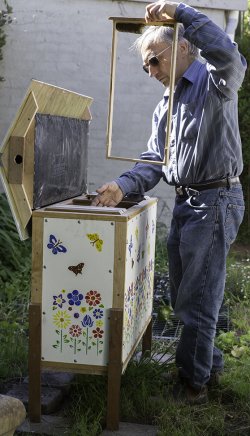
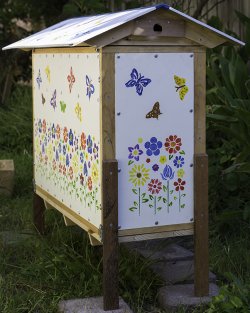
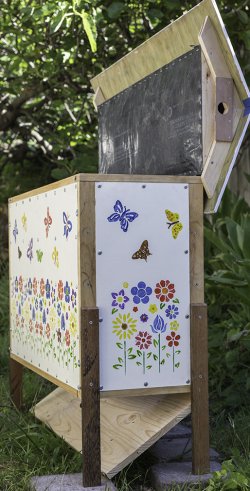
Andrew Janiak's Trough Hive (Melbourne, Australia)
7 February 2015
Double-wall plywood. Roof and bottom hinged for ease of access and ease of cleaning. Hinges and latches - stainless steel. Quilt incorporated in the roof. Roof currently painted treated plywood. Top bars have ends chamfered at 45 degrees to prevent perforating the quilt. Quilt presses the frames into place. The insulation material is pink foam slab. Frames have triangular section timber under the top bar for guidance -- i.e. 'V' shaped comb guides.
Initially two hives have been made, the first of the two shown below having been decorated.



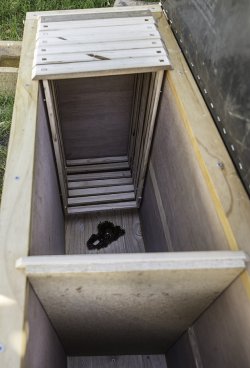
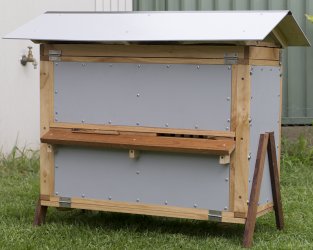
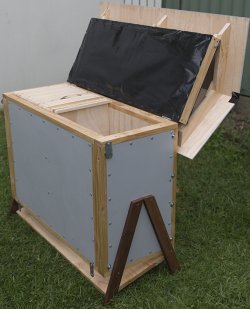
Frame spacing is controlled by top bars at the top and 3mm diameter 6mm long bamboo pins close to the bottom. Actually on each side there is a 3mm pin on one frame and a piece of 6mm plywood on another to accommodate any mismatch -- you cannot make it pin-to-pin. Frame distance from walls is controlled by four 3mm diameter 6mm long bamboo pins on the sides. Bamboo pins -- skewers. The frame-to-wall spacers help avoid squashing bees when withdrawing such deep frames.
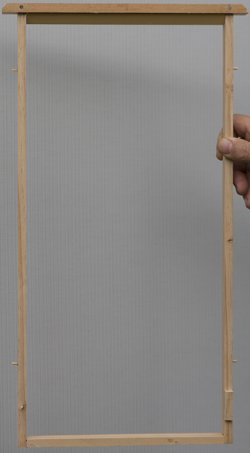
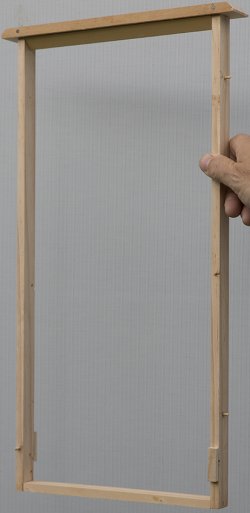
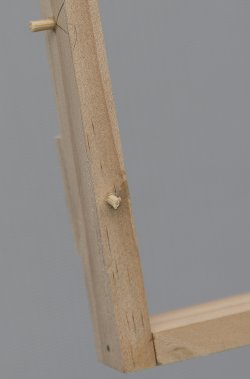
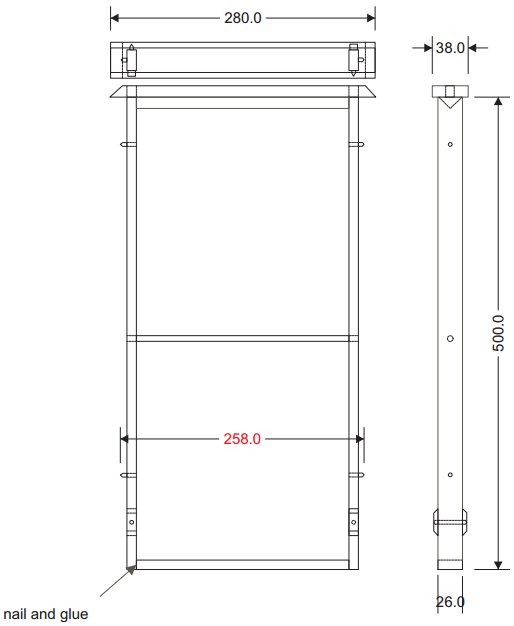
Below: detail of entrances and landing board

Entrances about 300 mm from the top. Two sets of entrance holes, inset 100 mm from each end of the front long side. This is to be able to move the nest as per Lazutin/Lubieniecki and also to be able, if the need be, to house two small colonies in a single box as an interim solution. If only one set of holes is used there will be only one honey section. Initially I made no landing board but saw quite a few bees falling off on landing and forced to make repeated approaches, so added one.
Below: detail of alternative entrance type, also with landing board:
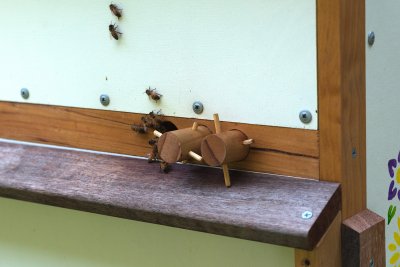
28 April 2015: sequence of comb photos starting from the follower board:
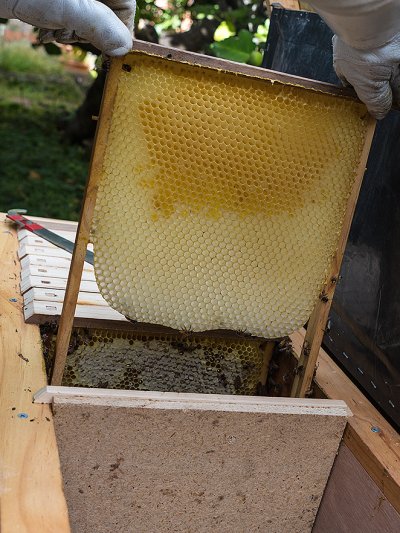
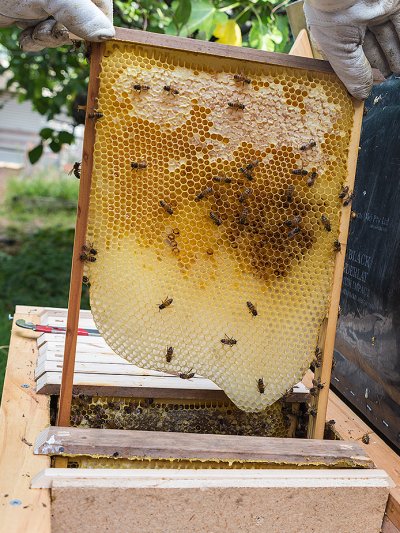
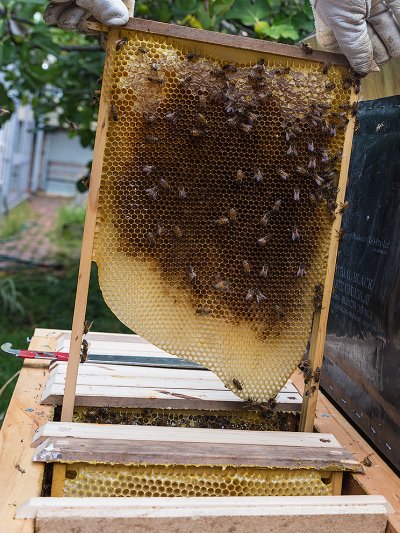
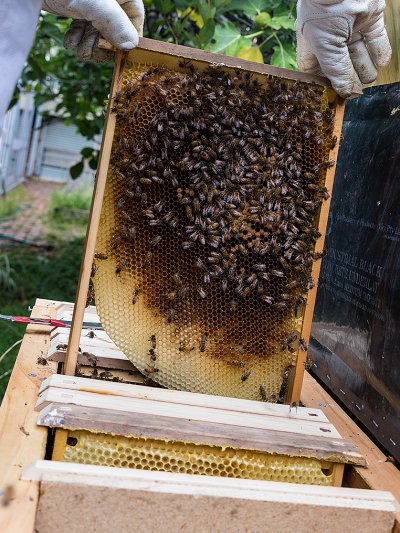
Notes: In one of his hive models Fedor Lazutin, author of Keeping Bees with a Smile, also has the entrance in between the top and the bottom. He does not explain why, but I have found his source -- a late 19th century book written by a Polish beekeeper Lubieniecki. Lazutin refers to him on page 234, and I discovered that the book, printed in 1856, then extended in 1872, had been translated into Russian and published in 2002.
There are two issues with entrances:
1. entrance options at both ends or even all along the hive front. An entrance along the whole front is in my opinion of little use, if any at all, and is technically troublesome, so I discarded it. I left the option of entrances at both ends in line with Lazutin, Crowdell and Harrell. I now use three 1" round ones rather than a narrow slit - easy to make and easy to close safely with just a piece of dowel.
2. placement of the entrance in relation to the hive top and bottom. Lubieniecki and Lazutin in one of its variants places the entrance about 500 mm from the top of frames, so well away from the actual hive bottom. It is in line with what happens in tree cavities where usually there is quite a lot of rot and room below the entrance and this area works as a rubbish sump. It makes sense to me. Placing an entrance at the hive bottom forces bees to do an unnecessary cleaning work and is very anthropomorphic. Lubieniecki refers to experiments where in a log hive a narrow slot was provided from top to bottom. He claims that bees propolised it all, except an entrance left about 500 mm from the top. I use this placement for an entrance, but will keep an eye on whether bees are keen to build comb below the entrance level. At the moment I am under impression that if they can expand both horizontally and vertically, they will first go vertically until reaching about the entrance level and then prefer to go horizontally -- expand combs. This is not what one would prefer. I will keep an eye on it, these are only early impressions. If this confirms, I would shift the entrance to around frame bottom -- still at least 100mm from the actual hive bottom.
Lubieniecki also comments on the nonsense of an entrance at the bottom. He says that in tree hives the bottom is the rubbish tip. I came to the conclusion that it makes sense - bees are not little aeroplanes or people, they can enter and exit the hive upside down or whatever and walk vertical walls. Placing an entrance well above the bottom means that bees do not have to walk over rubbish, or fallen varroa for that matter. If they can chase a small hive beetle (SHB) down, it has a long way to go up the wall before it can reach the comb. Same if SHB or wax moth larvae hatch at the hive bottom. Equally any varroa that falls down has a very long way to climb and no bees conveniently walking by. After discussing the matter in depth, "old masters" (Lubieniecki and another respected expert from ~1890s) claim that the "cold way" is the one preferred by bees so it better be preferred by beekeepers.
For a full set of plans in PDF format please
contact: andrew (dot) janiak (at) gmail (dot) com